Wild Collected, Aquarium Conditioned
Kaudern's Cardinalfish
Pterapogon Kauderni, Indonesia
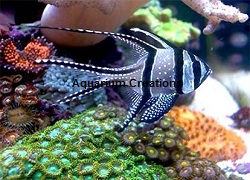
Description:
The Kaudern's Cardinalfish (Pterapogon kauderni) is a small tropical cardinalfish (family Apogonidae). Also known as the Banggai Cardinalfish or Longfin Cardinalfish, it has a majority of silver highlighted by black striping and white dots on the body and on the long fins. Popular in the aquarium trade. It is among the relatively few marine fish to have been bred regularly in captivity, but significant numbers are still captured in the wild. Grows up to about 3 inches in total length. It has a distinctive contrasting pattern of black and light bars with white spots. This species is easily differentiated from all other cardinalfish by its tasseled first dorsal fin, elongate anal and second dorsal fin rays, deeply forked caudal fin, and color pattern consisting of three black bars across the head and body and prominent black anterior edges on the anal and second dorsal fin. Males can be differentiated from females by a conspicuous enlarged oral cavity, which is apparent only when they are brooding.
Tank Recommendations: You need a minimum of a 30 gallon or larger aquarium with live rock for caves and hiding places. Keep with peaceful tank mates. May be kept in small groups of up to a 1/2 dozen but keep away from large groups unless you have an aquarium of 125 gallons or more.
Feeding: Requires a well balanced diet of meaty foods such as feeder shrimp, flake foods, pellet foods, marine flesh, bloodworms, and depending on its size, live feeder fish.
Level of Care: Moderate
Reef CompatibilityExcellent/FONT>
Approximate Purchase Size:
Large 1-1/2" to 2-1/4"
$29.99 ea. ~ 3 for $84.99
|
|
Captive Bred
Kaudern's Cardinalfish
Pterapogon Kauderni
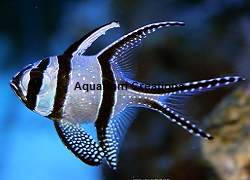
Description:
The Kaudern's Cardinalfish (Pterapogon kauderni) is a small tropical cardinalfish (family Apogonidae). Also known as the Banggai Cardinalfish or Longfin Cardinalfish, it has a majority of silver highlighted by black striping and white dots on the body and on the long fins. P. kauderni is a mouthbrooding species with no planktonic larval stage, which makes it among one of the easiest marine species to breed in captivity. The male holds the fertilized eggs in his mouth until full development, and releases them as juveniles. Banggai Cardinals have a spawn size of anywhere from 12 to 50 fry, which develop in the male's mouth for 20-24 days. They will spawn every 30 days and it is not uncommon to observe this in home aquaria. The juveniles emerge ready to take newly hatched brine shrimp. For these reasons, this is a species many home aquarists have bred and reared.
Tank Recommendations: You need a minimum of a 30 gallon or larger aquarium with live rock for caves and hiding places. Keep with peaceful tank mates. May be kept in small groups of up to a 1/2 dozen but keep away from large groups unless you have an aquarium of 125 gallons or more.
Feeding: Requires a well balanced diet of meaty foods such as feeder shrimp, flake foods, pellet foods, marine flesh, bloodworms, and depending on its size, live feeder fish.
Level of Care: Moderate
Reef CompatibilityExcellent
Approximate Purchase Size:
1-1/2" to 2"
$29.99 ea. ~ 3 for $84.99
|
|
Red Spotted Pajama Cardinals
Sphaeramia nematoptera
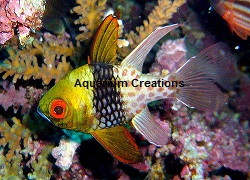
Description:
A hardy and peaceful fish that can live many years in a marine aquarium, the Captive Bred Pajama cardinal fish (Sphaeramia nematoptera) is a species of fish belonging to the Apogonidae family. It is a popular aquarium fish. It grows to a total length of about 2.5 inches and features distinctive red eyes and a broad dark vertical 'waistband' with scattered red spots toward the tail with a rainbow of other colors around the boday. It is considered to be of low vulnerability, and is distributed throughout much of the West Pacific, from Java to Fiji, and from the Ryukyu Islands south to the Great Barrier Reef. It will typically not bother other fish, or invertebrates and is therefore considered reef safe. As they are a social fish, it is common to keep them in groups of five or more. They have been known to breed in captivity, unlike most marine fish, but captive bred specimens are only rarely available. Interesting fact: If they are kept with a long spined sea urchin they will hide among the spines when they feel threatened.
Tank Recommendations: Red Spotted Pajama Cardinal fish should be kept in small schools in suitably sized aquariums of at least 30 gallons. Because the Spotted Cardinalfish is a slow and methodical swimmer, it should be housed with peaceful tankmates and offered a plethora of hiding places amongst rockwork or plants. Most Spotted Cardinal fish will tend to hide in sea grass or other plants. Some may also camouflage themselves against long spined sea urchins. Like many other schooling fish, the Spotted Cardinal fish will form a strict hierarchy when kept in small groups within the aquarium. However, unlike some social fish, this member of the Apogonidae family does not use aggression to exert dominance over other cardinalfish.
Feeding:The Spotted Cardinal fish requires a well balanced diet of meaty foods such as feeder shrimp, flake foods, pellet foods, marine flesh, bloodworms, and depending on its size, live feeder fish.
Level of Care: Easy
Reef Compatibility Excellent
Approximate Purchase Size:
1-1/4" to 1-3/4"
$21.99 ea. ~ 3 for $61.99
|
|
Captive Bred
Red Spotted Pajama Cardinals
Sphaeramia nematoptera
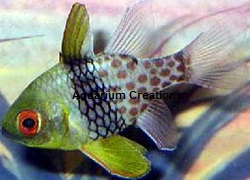
Description:
ORA is the first hatchery to successfully commercially breed this colorful Cardinal. Like other Cardinals they are mouth brooders however the larvae do not develop in the mouth. They are released upon hatch and are among the most challenging larvae to work with. Most hobbyists assume that all Cardinals reproduce just like a Banggai Cardinal and often overlook the significance of the availability of other more difficult species. They grow to a total length of about 2.5 inches and feature distinctive red eyes and a broad dark vertical 'waistband' with scattered red spots toward the tail with a rainbow of other colors around the body. They typically will not bother other fish, or invertebrates and are considered reef safe. As a social fish, it is common to keep them in groups of five or more. Interesting fact: If they are kept with a long spined sea urchin they will hide among the spines when they feel threatened.
Tank Recommendations: Red Spotted Pajama Cardinal fish should be kept in small schools in suitably sized aquariums of at least 30 gallons. Because the Red Spotted Cardinalfish is a slow and methodical swimmer, it should be housed with peaceful tank mates and offered a plethora of hiding places amongst rockwork or plants. Most Spotted Cardinal fish will tend to hide in sea grass or other plants. Some may also camouflage themselves against long spined sea urchins. Like many other schooling fish, the Spotted Cardinal fish will form a strict hierarchy when kept in small groups within the aquarium. However, unlike some social fish, this member of the Apogonidae family does not use aggression to exert dominance over other cardinalfish.
Feeding:The Spotted Cardinal fish requires a well balanced diet of meaty foods such as feeder shrimp, flake foods, pellet foods, marine flesh, bloodworms, and depending on its size, live feeder fish.
Level of Care: Easy
Reef Compatibility Excellent
Approximate Purchase Size:
3/4" to 1"
$27.00 ea. ~ 3 for $75.00
|
|
Aquarium Conditioned
Orbic Cardinal
Sphaeramia orbicularis,Indo-Pacific
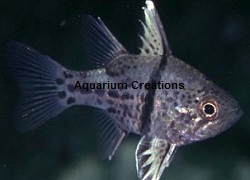
Description:
The Orbiculate Cardinalfish (Sphaeramia orbicularis) is a species of cardinalfish from the Apogonidae family. One of the hardiest members of the cardinalfish family, it is naturally found in coastal areas throughout the Indo Pacific region, loosely congregated in groups hovering in caves and overhangs. Growing up to 4" in the aquarium, they will develop a distinct black belt across its silvery midsection with a scattered cluster of dark spots near the tail. Mostly active during the evening, Orbic Cardinalfish will vigorously eat all types of prepared aquarium foods. A great fish for the beginning marine hobbyist. While it is not a common marine aquarium fish, it can be a good beginner fish.
Tank Recommendations: Orbic Cardinal fish should be kept in small schools in suitably sized aquariums of at least 30 gallons. Because the Orbic Cardinal is a slow and methodical swimmer, it should be housed with peaceful tank mates and offered a plethora of hiding places amongst rockwork or plants. Most Spotted Cardinal fish will tend to hide in sea grass or other plants. Some may also camouflage themselves against long spined sea urchins. Like many other schooling fish, the Orbic Cardinal fish will form a strict hierarchy when kept in small groups within the aquarium. However, unlike some social fish, this member of the Apogonidae family does not use aggression to exert dominance over other cardinalfish.
Feeding:The Orbic Cardinalfish requires a well balanced diet of meaty foods such as feeder shrimp, flake foods, pellet foods, marine flesh, bloodworms, and depending on its size, live feeder fish.
Level of Care: Easy
Reef Compatibility Excellent
Approximate Purchase Size:
1" to 1-1/2"
$15.99 ea. ~ 3 for $45.99
|
|
Captive Bred
Orbic Cardinal
Sphaeramia orbicularis,Indo-Pacific
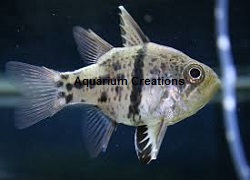
Description:
The Orbiculate Cardinalfish (Sphaeramia orbicularis) is a species of cardinalfish from the Apogonidae family. One of the hardiest members of the cardinalfish family, it is naturally found in coastal areas throughout the Indo Pacific region, loosely congregated in groups hovering in caves and overhangs. Growing up to 4" in the aquarium, they will develop a distinct black belt across its silvery midsection with a scattered cluster of dark spots near the tail. Mostly active during the evening, Orbic Cardinalfish will vigorously eat all types of prepared aquarium foods. A great fish for the beginning marine hobbyist. While it is not a common marine aquarium fish, it can be a good beginner fish.
Tank Recommendations: Orbic Cardinal fish should be kept in small schools in suitably sized aquariums of at least 30 gallons. Because the Orbic Cardinal is a slow and methodical swimmer, it should be housed with peaceful tank mates and offered a plethora of hiding places amongst rockwork or plants. Most Spotted Cardinal fish will tend to hide in sea grass or other plants. Some may also camouflage themselves against long spined sea urchins. Like many other schooling fish, the Orbic Cardinal fish will form a strict hierarchy when kept in small groups within the aquarium. However, unlike some social fish, this member of the Apogonidae family does not use aggression to exert dominance over other cardinalfish.
Feeding:The Orbic Cardinalfish requires a well balanced diet of meaty foods such as feeder shrimp, flake foods, pellet foods, marine flesh, bloodworms, and depending on its size, live feeder fish.
Level of Care: Easy
Reef Compatibility Excellent
Approximate Purchase Size:
1"
$23.99 ea. ~ 3 for $69.99
|
|
Captive Bred
Black Cardinalfish
Apogonichthyoides melas
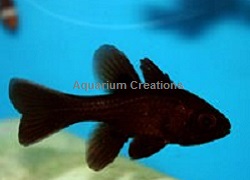
Description:
The Black Cardinalfish is a hardy member of the Apogonid family that has recently gained popularity in the aquarium hobby. Their dark color, large head and swimming behavior with all fins erect has a likeness to a hovering Coelacanth. Juvenile Black Cardinalfish exhibit a white, almost translucent posterior half with a pitch black anterior half. As they mature the white color recedes to only the unpaired fins. Finally as mature adults, they lose any trace of white color and range from dark mocha to pitch black depending on their mood. This species also exhibits ocelli or eyespots at the base of the second dorsal and anal fins. Black Cardinalfish are paternal mouthbrooders and lay very large spawns. Unlike the Banggai Cardinal the tiny larvae are released from the mouth immediately upon hatching. Their maximum size is 4.5" and they are fairly peaceful with other reef fishes. They may be kept singly or in a group. Only during spawning will females become somewhat combative with others of the same species.
Tank Recommendations: Captive Bred Black Cardinalfish should be kept single or in small schools in suitably sized aquariums of at least 30 gallons. The Black Cardinalfish should be housed with peaceful tank mates and offered hiding places amongst the rockwork or plants.
Feeding:The Black Cardinalfish requires a well balanced diet of meaty foods such as feeder shrimp, flake foods, pellet foods, marine flesh, bloodworms, and depending on its size, live feeder fish.
Level of Care: Easy
Reef Compatibility Excellent
Approximate Purchase Size:
3/4" to 1"
$20.99 ea. ~ 3 for $59.99
|
|
Captive Bred
Yellowstriped Cardinalfish
Ostorhinchus cyanosoma
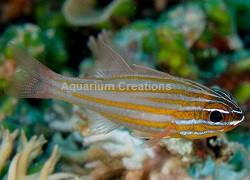
Description:
The Captive Bred Yellowstriped Cardinalfish (Ostorhinchus cyanosoma) has a silver background color with bright orange-yellow stripes running down the length of its body. Their eyes and nape fade into a black color. They achieve a maximum size of approximately 3 inches. This species is also known as the Orange Line Cardinal and was formerly classified as Apogon cyanosoma. With many classic Cardinalfish characteristics, they are paternal mouthbrooders and prefer to live in small groups. Like most other Apogonidae species they are peaceful fishes that don't pose a threat to other reef aquarium inhabitants, with the exception of very small shrimps. This makes Yellowstriped Cardinalfish ideal candidates for almost every type of community reef aquarium. The Yellowstriped Cardinalfish is a rather challenging species to produce making its availability very limited
Tank Recommendations: The Yellowstriped Cardinalfish should be kept in small schools in suitably sized aquariums of at least 30 gallons. Because The Yellowstriped Cardinalfish is a slow and methodical swimmer, it should be housed with peaceful tank mates and offered a plethora of hiding places amongst rockwork or plants.
Feeding:The Yellowstriped Cardinalfish requires a well balanced diet of meaty foods such as feeder shrimp, flake foods, pellet foods, marine flesh, bloodworms, and depending on its size, live feeder fish.
Level of Care: Easy
Reef Compatibility Excellent
Approximate Purchase Size:
1" to 1-1/4"
$29.99 ea
|
|
Captive Bred
Yellow Cardinalfish
Ostorinchus luteus
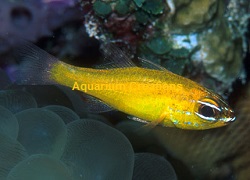
Description:
The Captive Bred Yellow Cardinalfish is a peaceful, schooling fish that is naturally found in groups under ledges or caves during the day, becoming more active at night. Rarely available to aquarists from the wild, this species is now available as a colorful, aquacultured addition to your home aquarium or reef tank. Yellow Cardinals reach a max size of approximately 1.5". They thrive in a variety of aquarium settings, readily taking prepared foods and getting along with other peaceful tank mates. Like most cardinalfish, the males actually hold the fertilized eggs in their mouths during development.
Tank Recommendations: The Yellow Cardinalfish should be kept in aquariums of at least 10 gallons. Because The Yellow Cardinalfish is a slow and methodical swimmer, it should be housed with peaceful tank mates and offered a plethora of hiding places amongst rockwork or plants.
Feeding:The Yellow Cardinalfish requires a well balanced diet of meaty foods such as feeder shrimp, flake foods, pellet foods, marine flesh, bloodworms, and depending on its size, live feeder fish.
Level of Care: Easy
Reef Compatibility Excellent
Approximate Purchase Size:
1" to 1-1/4"
$29.99
|
|









